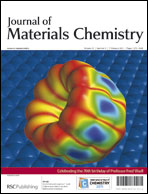A solid-state switch containing an electrochemically switchable bistable poly[n]rotaxane†
Abstract
Electrochemically switchable bistable main-chain poly[n]rotaxanes have been synthesised using a threading-followed-by-stoppering approach and were incorporated into solid-state, molecular switch tunnel junction devices. In contrast to single-station poly[n]rotaxanes of similar structure, the bistable
![Graphical abstract: A solid-state switch containing an electrochemically switchable bistable poly[n]rotaxane](/en/Image/Get?imageInfo.ImageType=GA&imageInfo.ImageIdentifier.ManuscriptID=C0JM02269A&imageInfo.ImageIdentifier.Year=2011)
- This article is part of the themed collection: Celebrating the 70th birthday of Professor Fred Wudl

 Please wait while we load your content...
Please wait while we load your content...